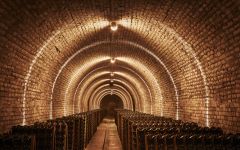Krug Brut in Wood Box 1998
-
Wine
Spectator -
Wine &
Spirits -
Wine
Enthusiast -
Robert
Parker




Product Details
Your Rating
Somm Note
Winemaker Notes
Krug Vintage is a statement – Krug's definitive, one-off interpretation of the character of an outstanding year. The blend contains wines exclusively from that year.
Characterized by the warm glow of yellow gold and the fragrant aroma of flowers in bloom, Krug 1998 is an enchanting champagne of astonishing purity and precision. From its creamy, caressing texture, through its full, finely balanced flavors, to its extraordinarily long finish, it is a study in harmony, delicate, refined, and captivating. Think notes of red berries, stewed fruit, brioche, almond, gingerbread, and citrus.
Krug 1998 could be enjoyed with fish with fine flesh such as sea bass or turbot accompanied by lemon sauces or citrus fruits, as well as spicy or exotic dishes (Japanese, Chinese, Indian, Thai), with crystallized ginger and other spices.
Professional Ratings
-
Wine Spectator
This harmonious Champagne offers luxurious texture and powerful, focused acidity, showing aromatic accents of spring blossom, crushed thyme and chai, with rich notes of lemon meringue, hazelnut, black currant and fresh porcini mushroom. The full package. Impressive. Drink now through 2028.
-
Wine & Spirits
If you are a Krug classicist, this is your wine. There’s nothing like it, other than prior great vintages of Krug (and perhaps the 2002, when that breaks away from the cellar). My notes on this wine are extensive, but the one word underlined is Kruggy: It has the power and stodgy brilliance of Krug. The depth of the wine is hard to describe, with ethereal quince and sweet spice providing sunniness to counter the gravitas of the structure. It brought to mind the crostini topped with uni and lardo at Marea in NYC—a dish that would bring out the layers of lime, lemon zest and shellfish broth in this wine. It would also match well with rich Lyonnaise cuisine, a foie gras terrine, duck confit…whether you open it now or in 20 years.
-
Wine Enthusiast
Although the aromas are toasty, the flavors are still so fresh, rich, complex. This is a wonderful expression of taut minerality, pure citrus zest and then a wood-toast character that gives the wine both richness and sophistication. Given the fresh, intense fruit, this will certainly age for many years.
Cellar Selection -
Robert Parker's Wine Advocate
Krug's 1998 Brut Vintage is an excellent choice for drinking today, as the classic Krug style is rich, alive and totally vivid. Honey, almonds, smoke, graphite and dried apricots are some of the many aromas and flavors found in this rich, enveloping Champagne. A wine of texture and depth, the 1998 impresses for its vinous personality and terrific balance. Lively veins of underlying acidity suggest the 1998 will drink well for many years to follow. This is one of the best bottles of the 1998 I have ever tasted. Anticipated maturity: 2012-2038.
Other Vintages
2000-
James
Suckling -
Wine
Spectator -
Wine &
Spirits -
Robert
Parker









Krug has always lived up to its reputation as the first and only Champagne House to create exclusively prestige Champagnes every year since its foundation.
The House was established in Reims in 1843, by Joseph Krug, a visionary non-conformist with an uncompromising philosophy. Having understood that the true essence of Champagne is pleasure itself, his dream was to craft the very best Champagne he could offer, every single year, regardless of annual variations in climate. Paying close attention to the vineyard’s character, respecting the individuality of each plot and its wine, as well as building an extensive library of reserve wines from many different years allowed Joseph Krug to fulfil his dream.
With a very original approach to Champagne making, he decided to go beyond the notion of vintage to create the most generous expression of Champagne, every year. Thus, he founded a House in which all Champagnes are of the same level of distinction.
Six generations of the Krug family have perpetuated this dream, enriching the founder’s vision and savoir faire.
Further elaborating on the notion of individuality, for Krug’s Cellar Master Julie Cavil, each plot of grapes, through its wine, is like a single ingredient to a chef: carefully selected, and critical to the final composition. Each year, Krug honors this philosophy by inviting chefs from around the world to interpret a single ingredient, crafting unexpected recipes to pair with a glass of Krug Grande Cuvée or Krug Rosé. This year’s ingredient is the Onion.
The unspoken onion is a key component of almost every fundamental recipe from stocks, sauces and stews to baked goods and roasts. Its multifaceted expressions beautifully marry both the fullness of flavors and aromas of Krug Grande Cuvée the elegance and boldness of Krug Rose.

Representing the topmost expression of a Champagne house, a vintage Champagne is one made from the produce of a single, superior harvest year. Vintage Champagnes account for a mere 5% of total Champagne production and are produced about three times in a decade. Champagne is typically made as a blend of multiple years in order to preserve the house style; these will have non-vintage, or simply, NV on the label. The term, "vintage," as it applies to all wine, simply means a single harvest year.

Associated with luxury, celebration, and romance, the region, Champagne, is home to the world’s most prized sparkling wine. In order to bear the label, ‘Champagne’, a sparkling wine must originate from this northeastern region of France—called Champagne—and adhere to strict quality standards. Made up of the three towns Reims, Épernay, and Aÿ, it was here that the traditional method of sparkling wine production was both invented and perfected, birthing a winemaking technique as well as a flavor profile that is now emulated worldwide.
Well-drained, limestone and chalky soil defines much of the region, which lend a mineral component to its wines. Champagne’s cold, continental climate promotes ample acidity in its grapes but weather differences from year to year can create significant variation between vintages. While vintage Champagnes are produced in exceptional years, non-vintage cuvées are produced annually from a blend of several years in order to produce Champagnes that maintain a consistent house style.
With nearly negligible exceptions, . These can be blended together or bottled as individual varietal Champagnes, depending on the final style of wine desired. Chardonnay, the only white variety, contributes freshness, elegance, lively acidity and notes of citrus, orchard fruit and white flowers. Pinot Noir and its relative Pinot Meunier, provide the backbone to many blends, adding structure, body and supple red fruit flavors. Wines with a large proportion of Pinot Meunier will be ready to drink earlier, while Pinot Noir contributes to longevity. Whether it is white or rosé, most Champagne is made from a blend of red and white grapes—and uniquely, rosé is often produce by blending together red and white wine. A Champagne made exclusively from Chardonnay will be labeled as ‘blanc de blancs,’ while ones comprised of only red grapes are called ‘blanc de noirs.’
